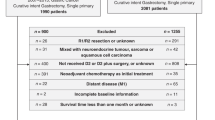Summary
For classification of perigastric lymph node metastases in gastric cancer, only topographical aspects are taken into consideration at present. As a numerical classification for lymph node metastases was proposed recently, the current problem is that of determining the number of dissectable perigastric lymph nodes and also assessing the quality of nodal dissection. The perigastric lymph nodes of 10 adults without gastric disease were therefore evaluated microscopically by a serial section technique. On average a total of 36.2±15.2 perigastric lymph nodes were found, e.g. 14.9±14.1 lymph nodes on the greater and 7.4±4.8 on the lesser curvature. These figures are similar to those in fetuses and newborn infants, but they exceed the numbers of perigastric lymph nodes reported in the literature for adults with or without gastric cancer. This difference could be attributable to our use of the serial section technique, because the so-called “micro-lymph nodes” with a diameter of less than 1.5 mm are consequently included in this study. Our results support the assumption, that pathologic processes do not result in any real increase of regional lymph nodes, but in an activation and enlargement of fetal lymph node reserve.
Résumé
Pour la classification des métastases lymphatiques périgastriques du cancer de l'estomac, seules les données topographiques sont prises en compte actuellement. Comme une classification numérique des métastases par voie lymphatique a été proposée récemment, le problème actuel est de déterminer le nombre de nœuds lymphatiques périgastriques disséqués et aussi d'évaluer l'aspect qualitatif de cette dissection. Les nœuds lymphatiques périgastriques de 10 sujets adultes indemnes de maladie gastrique, ont ainsi été étudiés au microscope selon une technique de coupes sériées. En moyenne, un total de 36,2±15,2 nœuds lymphatiques gastriques a été trouvé, soit 14,9±14,1 nœuds lymphatiques sur la grande courbure de l'estomac et 7,4±4,8 sur la petite courbure. Ces chiffres sont identiques à ceux que l'on trouve chez les fœtus et les nouveaux-nés, mais ils dépassent le nombre des nœuds lymphatiques périgastriques rapportés dans la littérature pour les sujets adultes avec ou sans cancer gastrique. Cette différence pourrait être imputable à notre utilisation d'une technique de coupes sériées, les nœuds dénommés «micronœuds lymphatiques» d'un diamètre inférieur à 1,5 mm se trouvant de ce fait compris dans cette étude. Nos résultats amènent à penser que les processus pathologiques ne provoquent pas une augmentation réelle des nœuds lymphatiques régionaux, mais entraînent une activation et un développement du système des nœuds lymphatiques existant depuis la vie fœtale.
Similar content being viewed by others
References
Arslan Pagnini C, Rugge M (1985) Advanced gastric cancer and prognosis. Virchows Arch A 406: 213–221
Black MM, Freeman C, Mark T, Harvey S, Cutler SJ (1971) Prognostic significance of microscopic structure of gastric carcinoma and their regional lymph nodes. Cancer 27: 703–711
Borchard F, Mester A, Lohe B, Thon K, Dost P, Betz P (1989) Größe, Zahl und metastatischer Befall der perigastrischen Lymphknoten beim Magenkarzinom. Vergleich mit fetalen und adulten Normalbefunden. Verh Dtsch Ges Path 73: 478
Börsch G, Mai U, Rühl GH (1988) Campylobacter pylori, eine kritische Bestandsaufnahme. Fortschritte der Medizin, 106 Jg, 11: 217–222
Coller FA, Kay EB, McIntyre RS (1960) Regional lymphatic metastases of carcinoma of the stomach. Arch Surg 43: 748–761
Eisenberg H, Sullivan PD, Foote FM (1967) Trends in survival of digestive system cancer patients in Connecticut 1935–1962. Gastroenterology 53: 528–546
Eker R, Efskind J (1960) The pathology and prognosis of gastric carcinoma based on 1,314 partially and totally resected cases. Acta Chir Scand Suppl 264: Larvik
Jamieson JK, Dobson JF (1907) The lymphatic system of the stomach. Lancet 20: 1061–1066
Kajitani T, Miwa K (1979) Treatment results of stomach carcinoma in Japan 1963–1966. WHO-CC Monograph No. 2, National Cancer Center Press
Keighley MRB, Moore J, Raginski C, Pavell J, Thompson H (1984) Incidence and prognosis of N4 node involvement in gastric cancer. Br J Surg 71: 863–866
Kim JP, Jung SE (1987) Patients with gastric cancer and their prognosis in accordance with number of lymph node metastases. Scand J Gastroenterol 22: Gastric Cancer Suppl 33–35
Kodama Y, Sugimachi K, Soejima K, Matsusaka T, Inokuchi K (1981) Evaluation of extensive lymph node dissection for carcinoma of the stomach. World J Surg 5: 241–248
Kubik S (1980) Visceral lymphatic system. In: Viamonte M Jr, Rüttimann A (Hrsg.) Atlas of lymphography. Georg Thieme, Stuttgart-New York
Mishima Y, Hirayama R (1987) The role of lymph node surgery in gastric cancer. World J Surg 11: 406–411
Siewert JR, Lange J, Böttcher K, Karen Becker, Stier A (1986) Lymphadenektomie beim Magencarcinom. Langenbecks Arch Chir 368: 137–148
Soga J, Kobayashi K, Saito J, Fujimaki M, Muto T (1979) The role of lymphadenectomy in curative surgery of gastric cancer. World J Surg 3: 701–708
The general rules for the gastric cancer study in surgery and pathology. Part I. Clinical classification. Jpn J Surg 11: 127–139 (1981)
Wei TC, Hsu SC (1980) Evaluation of factors influencing the prognosis of gastric cancer after gastric resection. Taiwan I Hsuch Hui Tsu Chih 79: 205–219
Author information
Authors and Affiliations
Additional information
Dedicated to Prof. Hort on the occasion of his 65th birthday
Rights and permissions
About this article
Cite this article
Borchard, F., Betz, P. Number and size of perigastric lymph nodes in human adults without gastric cancer. Surg Radiol Anat 13, 117–121 (1991). https://doi.org/10.1007/BF01623884
Received:
Accepted:
Published:
Issue Date:
DOI: https://doi.org/10.1007/BF01623884




